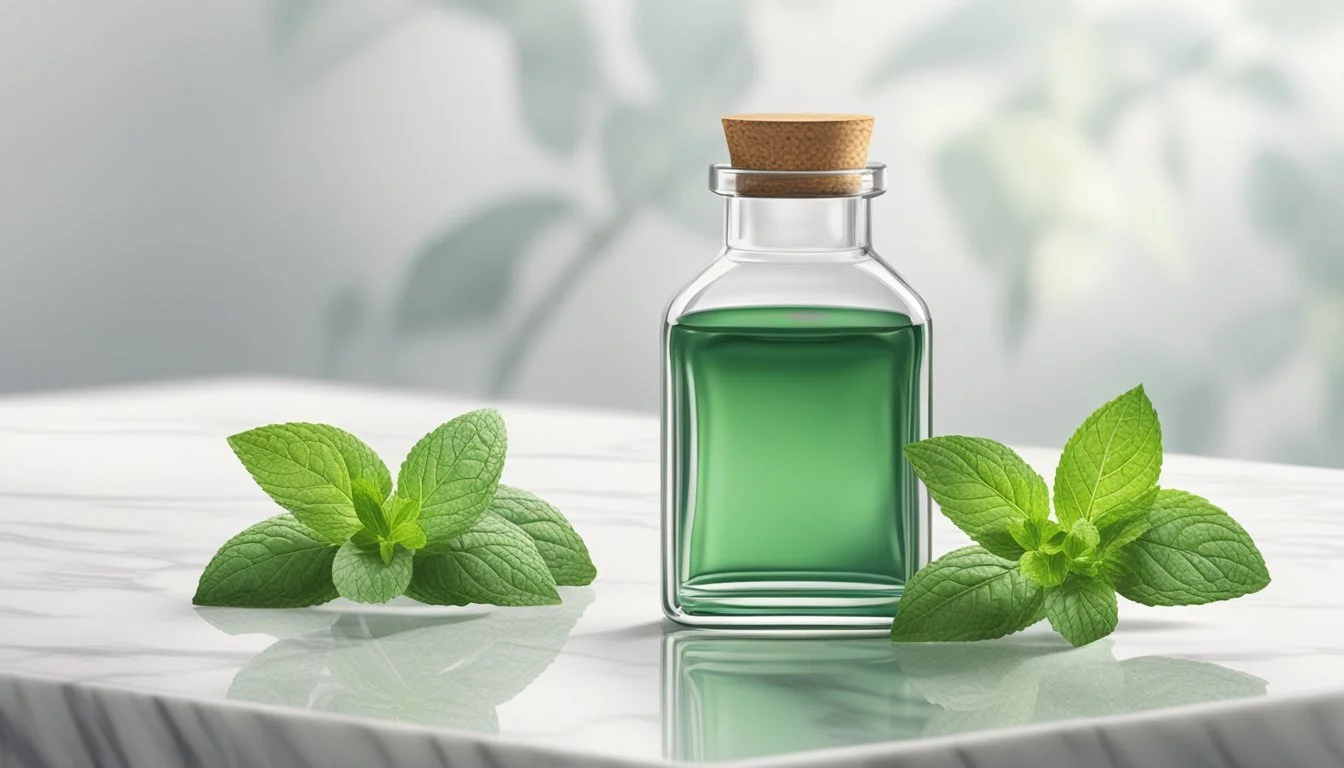Peppermint Extract Substitutes
Top Alternatives for Your Recipes
Peppermint extract is a concentrated essence commonly used in cooking and baking to infuse a fresh, minty flavor into various creations. This flavoring is derived from peppermint leaves and typically combines pure mint oil with alcohol, resulting in a strong and refreshing taste. It's a key ingredient in numerous recipes, from sweet confections like candies and holiday-themed desserts to savory dishes that benefit from its cool, piquant notes.
Finding substitutes for peppermint extract requires considering the desired outcome in terms of flavor profile. While an exact match is challenging to replicate due to its distinct taste, several alternatives can provide a similar sensation or complement the original intent of a recipe. When peppermint extract isn't available, chefs and bakers can rely on a range of other extracts and ingredients, including peppermint oil, spearmint extract, and even herbal mint tea, which all offer varying degrees of minty flavors suited to different palate preferences and culinary applications.
The versatility of peppermint extract substitutes expands the horizons for culinary experimentation. Whether seeking an exact flavor match or a complementary taste, the alternatives serve well in maintaining the integrity of the dish's flavor profile, although the ratios and intensity of these substitutes may vary. As with all ingredients, quality and appropriateness for consumption should be considered when selecting an extract or its substitute for use in cooking and baking.
Understanding Peppermint Extract
Peppermint extract is a concentrated flavoring derived from peppermint leaves, offering a distinctive minty taste and aroma, primarily used to enhance a variety of recipes.
Composition and Properties
Peppermint extract typically combines menthol, the primary component that gives it its characteristic cooling and refreshing effect, with alcohol, serving as a solvent to stabilize and preserve the liquid. The extract presents an intense flavor and must be used in moderation due to its high concentration of essential oils, primarily menthol.
Peppermint Oil: A more potent concentration than peppermint extract, used in even smaller quantities.
Flavor Profile: Cool and refreshing with a sharp, clean finish that can dominate other flavors if not used sparingly.
Culinary Uses
Peppermint extract shines in culinary applications where a burst of peppermint flavor is desired. It's commonly added to:
Chocolate: Enhances treats such as peppermint bark or chocolate mints.
Hot Chocolate: A few drops can transform a simple hot chocolate into a minty delight.
Baked Goods: Infuses cookies, cakes, and pastries with peppermint flavor.
Culinary Creations: Elevates the complexity of sauces, glazes, and seasonal offerings.
Its potent aroma and flavor require careful measurement to prevent overpowering dishes. Recipes often call for a small amount, measured in drops or fractions of a teaspoon, as part of a delicately balanced flavor profile.
Common Substitutes for Peppermint Extract
When a recipe calls for peppermint extract and it's not available, there are several alternative ingredients that can provide a similar minty flavor profile. The substitutes range from other members of the mint family to extracts with compatible flavors.
Mint Extract and Mint Leaves
Mint Extract: Though often confused with peppermint extract, mint extract typically comes from a blend of mint varieties and offers a less intense mint flavor. It can be used in a 1:1 ratio as a direct substitute for peppermint extract.
Mint Leaves: Fresh mint leaves can also impart the desired freshness. They require more quantity to match the concentrated flavor of the extract. About one tablespoon of finely chopped mint leaves can substitute for each teaspoon of peppermint extract needed.
Spearmint Extract and Spearmint Leaves
Spearmint Extract: Spearmint extract is a milder and sweeter member of the mint family. It can replace peppermint extract in equal amounts, providing a subtle, fresh flavor to dishes.
Spearmint Leaves: Fresh spearmint leaves offer a gentleness compared to peppermint. One can use them similarly to mint leaves, in an increased amount, to achieve the level of flavor specific to the original recipe with peppermint extract.
Other Herbal Extracts
Vanilla Extract: Vanilla extract is commonly available and can be a suitable substitute, especially in sweet dishes. The flavor is fundamentally different but can harmoniously blend in recipes that are adaptable to its warm profile.
Herbal Mint Tea: An infusion made from mint tea can be used when a liquid substitute is acceptable. The strength of the tea should be strong to effectively convey the minty essence.
Rosemary and Basil Extract: While not traditional substitutes, both rosemary and basil bear a certain aromatic kinship with mint. In certain savory applications, these herbs can be experimented with, keeping in mind their unique flavors and aromas.
Alcohol-Based Substitutes
When looking for an alcohol-based alternative to peppermint extract, the key is to find options that offer a similar minty profile. These substitutes not only replicate the peppermint flavor but also maintain the alcohol content, which can be essential for certain recipes where the evaporation of alcohol is necessary for texture and flavor development.
Peppermint Schnapps
Peppermint Schnapps is a clear, mint-flavored spirit that can serve as a substitute for peppermint extract. It typically has a high alcohol content and a bold peppermint flavoring, making it a suitable alternative in recipes requiring a pronounced mint taste. Since it's stronger in flavor and alcohol by volume (ABV), one should use a smaller amount of schnapps compared to extract. A general guideline is:
Peppermint Extract: 1 teaspoon
Peppermint Schnapps: 1/2 teaspoon
Adjust according to taste and the desired strength of peppermint flavoring.
Creme de Menthe
On the other hand, Creme de Menthe is a sweet, mint-flavored liqueur that comes in green and colorless varieties. It imparts a refreshing twist to dishes with its sweet and moderately minty profile. Given its lower mint intensity compared to peppermint extract, creme de menthe can be used in a 1:1 ratio for desserts that benefit from extra sweetness. However, the presence of sugar in creme de menthe should be considered, as it may affect the overall sweetness of the dish.
Use a straightforward equation to substitute:
Peppermint Extract: 1 teaspoon
Creme de Menthe: 1 teaspoon (adjust sugar in the recipe as needed)
Extract Alternatives in Recipes
Navigating through recipes can be challenging when one runs out of key ingredients like peppermint extract. This section outlines reliable substitutes for peppermint extract, ensuring culinary creations retain their intended flavor profiles across beverages, baked goods, and savory dishes.
Beverages and Teas
Herbal Mint Tea: An excellent replacement for peppermint extract in beverages, herbal mint tea offers a mild mint flavor when steeped and cooled. For a stronger peppermint note, one may substitute a brewed peppermint tea. This alternative is particularly useful in recipes like peppermint tea and minty iced beverages.
Baking and Desserts
Peppermint Oil: Given its concentrated nature, peppermint oil can be used sparingly—just a few drops in place of a teaspoon of extract—when preparing cookie dough or ice cream. Other sweets such as peppermint patties also benefit from this intense minty essence.
Spearmint Extract: Offering a sweeter and milder taste, spearmint extract works well as a 1:1 substitute in most baking and dessert contexts. This can include anything from cookies to chocolate-based desserts, adding depth to the dish’s flavor.
Savory Cooking
Mint Sauces: For savory applications, both herbal mint tea and spearmint extract can impart a refreshing twist to sauces. They blend seamlessly into both sweet and savory dishes, complementing the flavors without overwhelming them.
Non-Extract Flavoring Options
When looking for a substitute for peppermint extract, one has many options beyond just other extracts. From essential oils to seasonal candies, each alternative offers a unique flavor profile and aroma to enhance recipes in a natural and refreshing way.
Essential Oils and Infusions
Essential Oils: Peppermint oil is a natural substitute, significantly more concentrated than extracts. It's derived from the peppermint plant and carries a strong minty flavor. When using essential oils as a flavor component, one must use a carrier oil to dilute it due to its potency. Typically, only a drop or two of peppermint oil can replace a teaspoon of peppermint extract.
Infusions: To infuse a peppermint flavor, one can take fresh or dried peppermint leaves and steep them in a neutral-flavored alcohol such as vodka. This process extracts the oils and flavor from the leaves over a period, generally ranging from a few weeks to a couple of months. The resulting infusion has a longer shelf life and can be used as a milder flavoring alternative.
Candy Canes and Mint Candy
Candy Canes: Crunchy and sweet, candy canes provide a festive and sugary flavor. They can be crushed and dissolved into a variety of recipes, offering a similar refreshing twist to that of peppermint extract. Since they're typically made with actual peppermint oil, they can serve as an effective substitute during the holiday season.
Mint Candies: Similar to candy canes, other mint candies can be melted down to imbue dishes with a minty essence. This method works well in baking and dessert applications where additional sweetness is desirable. The flavor profile will vary depending on the type of mint candy used, with some lending a more intense minty note than others.
Seasonal Alternatives
Wintergreen Extract: While not peppermint, wintergreen extract offers a cooler and sharper mint aroma. This extract can be used in a 1:1 ratio as a peppermint extract substitute to provide a different yet equally refreshing flavor profile in seasonal dishes.
Refreshing Twist: In the absence of peppermint, one can consider other naturally cooling ingredients, such as spearmint, to achieve a similar sensory experience. Essential oils or infusions of spearmint can add a sweet and refreshing twist to various culinary creations.
Customizing Flavor Intensity
When cooking or baking, controlling the flavor intensity of peppermint is crucial for achieving the desired outcome. Replacing peppermint extract with alternative ingredients allows chefs and home cooks to precisely tailor the taste profile from intense to subtle.
Intense options:
Peppermint Oil: A highly concentrated alternative. Caution: Only use 1/4 teaspoon of oil for every teaspoon of extract to avoid overpowering the dish.
Subtle variations:
Spearmint Extract: Provides a gentler mint flavor with a sweet undertone. Replace on a 1:1 ratio with peppermint extract.
Peppermint Tea: Infuse into liquids to impart a light peppermint taste, suitable for subtle flavor enhancements.
To adjust the intensity within recipes, one can consider the following proportions:
Substitute Ratio to Peppermint Extract Taste Note Peppermint Oil 1:4 (oil) More intense, use sparingly. Spearmint Extract 1:1 Milder and sweeter. Peppermint Tea To taste Subdued and aromatic.
Remember, individual taste preferences vary, and a cautious approach to seasoning can always be intensified if necessary, but it cannot be undone. It's best to add these substitutes incrementally, tasting as one goes to determine when the ideal flavor intensity is achieved for their specific dish.
Selecting the Right Substitute
When seeking substitutes for peppermint extract, compatibility with the recipe is paramount. A suitable replacement should align closely with the flavor profile of peppermint extract, providing the desired refreshing minty essence.
Peppermint Oil: This concentrated essence is a direct derivative from peppermint leaves. Due to its potency, one should use a quarter teaspoon of oil for every teaspoon of extract required.
Spearmint Extract: Exhibits a gentler mint flavor and can be included in a 1:1 ratio with peppermint extract, introducing a sweeter note to dishes.
Mint Leaves: Fresh or dried, mint leaves infused in alcohol or water can impart a subtle minty flavor. Chopped leaves should steep in the chosen liquid for an extended period before use.
Herbal Mint Tea: A convenient substitution, particularly in liquid-based recipes. Mint tea can be steeped stronger for a more pronounced mint flavor.
Vanilla Extract: Though not minty, vanilla offers a sweetness and complexity that can be complimentary in recipes where mint is not the dominant flavor.
Substitute Amount Notes Peppermint Oil 1/4 tsp per tsp Use sparingly due to high concentration Spearmint Extract 1:1 Sweeter, milder mint flavor Mint Leaves To taste Fresh is best, steep to extract flavor Herbal Mint Tea To taste Use concentrated brew for stronger flavor Vanilla Extract 1:1 Different profile, adds sweetness
Each substitute brings a unique element to the recipe. When selecting, one must consider the desired outcome—the intensity of the mint flavor, the balance of sweetness, and how the substitute will complement the other ingredients.







